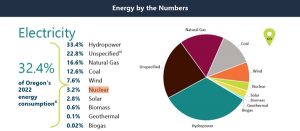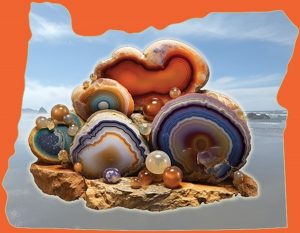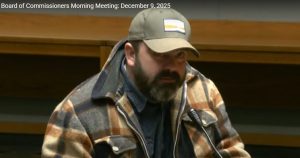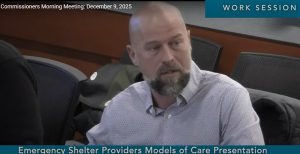McKenzie River Trust shares the latest on its restoration projects
10 min read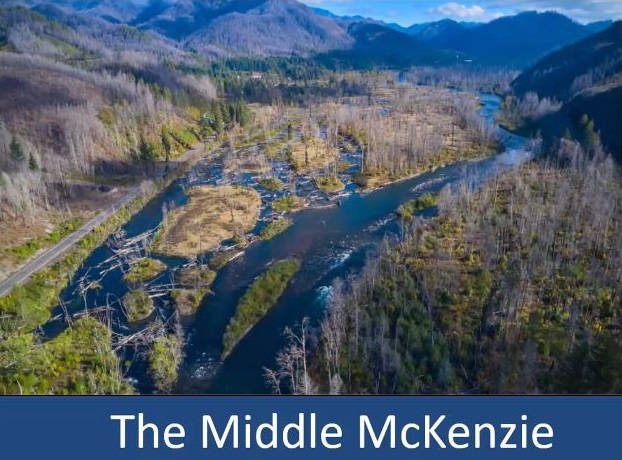
A status report to partners at the Metropolitan Waste Management Commission from the McKenzie River Trust. On Oct. 13, Executive Director Joe Moll.
Executive Director Joe Moll (McKenzie River Trust): Many of you are familiar, I know, with the McKenzie River Trust, and I’ll give a background for everyone, but one of the things that has been a professional goal of mine, and I think we’re starting to see, is this recognition that conservation and environment really is inseparable from community development.
[00:00:25] And I think the more that we can recognize that, there’s more and more talk about natural infrastructure and traditional gray infrastructure. And the more those two can intersect, I think the better off we’re finding things. And that really is one of the things that’s driving the work of the McKenzie River Trust.
[00:00:40] So we’re a nonprofit land trust. The trust has been around since 1989. We started to bring on staff early 2000s. I started as the executive director in 2005. We went from 1.5 staff toward now we have 20, 20 full-time FTE.
[00:00:57] We are not just limited to the McKenzie Valley anymore. Starting around 2001, we expanded to other areas, including the coast where landowners were saying, ‘We’re interested in private land conservation, but there’s not a group out here doing it.’
So we now have a staff member based in Newport. And we cover the area from the Siletz all the way down to the Umpqua, into and including all of the Upper Willamette watersheds, down towards Monroe on the Long Tom (River) where it intersects and even a little bit of work in Douglas County on the North Fork of the Umpqua there.
[00:01:33] So we kept the name because the McKenzie is an iconic river for the entire state of Oregon and we haven’t come up with anything better than geography.
[00:01:41] At the end of the day, our work is land and real estate-associated. We buy and/or accept land or development rights associated with land in donation. And then we manage that land, do habitat restoration on that land, sometimes we transfer that land to other entities. A lot of partnership work.
[00:02:02] I think that’s probably the biggest change in sort of operations over the time that I’ve been here is that we now have very formal relationships, not only with the watershed councils, but with the tribes that are in the area, sometimes with local, state, federal agencies as well.
[00:02:16] And there really is a sense that this is such a heavy lift that we do well working together. You know how complicated that is. Partnerships are difficult. We love each other, but like families, we also have all sorts of things to work with. And so it’s ongoing work.
[00:02:31] John Q: He described some of the habitat restoration projects.
[00:02:35] Joe Moll (McKenzie River Trust): Just below the confluence of the McKenzie and the Willamette Rivers, so obviously very close, just downstream from the treatment plant, an area now called Green Island (the Green family started farming it in the 1920s) has now been replanted into riparian forest, almost the entire area. There are some areas that are a little higher and more open grassland.
[00:02:56] And the other thing that has happened is the river has gone from that S to being cut right through the middle. So there’s been a real shift in the river dynamics there.
[00:03:04] That was the primary goal of the habitat restoration there. In an area with relative safety, limited infrastructure, to allow the river to recapture that floodplain and all of the benefits that we’re learning yet from that…
[00:03:17] Starting in the 1840s, we brought ships in and started pulling wood out of the river both for navigation and at the time, all the way through the 1940s, the thought was a cleaner river makes it easier for salmon to get upstream and spawn. Reasonable assumption at the time.
[00:03:34] The reality is a more jumbled, messy river is much more productive from a habitat standpoint: Deeper pools for hiding, more product, primary productivity, productivity of the bugs, the river becomes something that again extends way up into the canopy of the trees.
[00:03:51] When a river can spread out, you have water cooling, you have water cleaning, you have water retention, both in terms of slowing down the power, the destructive power of a flood, but also holding water through the hotter, drier summers that we’re experiencing. And all of the associated fish and wildlife benefits.
[00:04:09] We talk about fish spawning—what’s in the gravel now, those fish waiting to be, they’ll pop up in about January and this becomes their smorgasbord, a lot more food, a lot slower, safer water. So, as juvenile salmon start making their way down river, by the time they get to the ocean out of the Columbia, they’re bigger, they survive longer, and better returns. That’s the theory and the practice.
[00:04:33] The wild card, especially about salmon is the ocean, and ocean conditions determine so much. And anytime I go to Portland, I stand on those bridges across over the river and look down and think: How in the world does a Chinook salmon navigate through this and make it all the way up to the headwaters of the McKenzie River? Five- to seven-year life cycle, all sorts of wild cards out there.
[00:04:55] John Q: Upriver from the confluence, McKenzie River Trust just completed Phase 2 at Finn Rock Reach.
[00:05:01] Joe Moll (McKenzie River Trust): Further up on where the South Fork of the McKenzie comes in, Finn Rock Reach, the first phase of a similar habitat restoration project there, where again, the goal was to capture some of that natural infrastructure.
[00:05:15] So, again, now, being upstream of our drinking water supply, we’re looking to do more and more of this sort of work to give the river back some of its meandering floodplain where we can.
[00:05:26] Just a month ago, we completed Phase 2, so if you haven’t been on (Highway) 126 in the last couple months, when you drive by, this is very obvious, right on the side of the road. And it’s a bit of a reset. It kind of is reminiscent of what records show the river looked like historically, with a lot of downed wood, a lot of complexity that makes the river more than just a thin thread, but something that’s very deep and even up into the air because it’s so productive from a biological perspective.
[00:05:55] There may be some areas in here where we can add some complexity. We also know we’re going to have floods. We’re going to continue to have floods and this river is probably going to continue to shift. And again, giving the river that ability does take some pressure off of the infrastructure we have downstream.
[00:06:12] You know, that EWEB is putting in a new water plant starting what? ’26, ’27 maybe? And so, again, investment in upstream really does affect us downstream.
[00:06:24] John Q: He acknowledged that putting wood back into the river creates more risk for the people who work on the river every day.
[00:06:31] Joe Moll (McKenzie River Trust): So the combination of navigation by boats, which is their bread and butter and their lifestyle, and they’ve known, they know people who have died. I’m sure they know people who have drowned in rivers that have had strainers and other sorts of things. So I think it’s primarily a human safety concern, which I share.
[00:06:48] And I think it would be irresponsible for me to say, ‘Oh, it’ll never be a problem.’ I think there will be. I think that as we incorporate more natural solutions and let the river have its way a little bit more, we are inviting a little bit more risk. I say we need to balance that because we know the risks of letting the river die, like rivers have been.
[00:07:06] I think that’s one of their primary concerns. There was probably some additional concern that as rivers we know change, that is it possible that we’ve made it easier for this channel to shift back in this direction? We go through all of the same modeling that you would do for building up there. So we have 100-year water flood model and from a modeling standpoint, it says, no, the river is going to stay there until there’s a big flood.
[00:07:33] When there’s a big flood, sure, it could shift back. And us dealing with those wild cards is something that we’re always going to have to deal with. Notably, the 1964 flood: ‘64 reshuffled everything up there. It’ll happen again, even with the dams. So I think the concern is, have we increased the risk of something catastrophic happening?
[00:07:54] We’re going on the assumption that no, we’re actually reducing it because as you give the river the space to spread out, even in high water, that strong, powerful reshifting, the river is less likely to occur because it’s spread over a larger area and the power of the river gets displaced that way.
[00:08:11] But it’s bets. We’re taking bets, no question.
[00:08:13] So I think it’s important to listen to them because those guys are on the river every day. They know it. They see the changes; they’ve seen things; they’ve watched what’s happened; seen changes. So we do. We have a strong relationship with the guys and we have a lot of good heated arguments about what’s good and what’s not for the river. So that input is important. I look forward to continuing to work with them.
[00:08:34] John Q: McKenzie River Trust is also working on projects along the coast.
[00:08:40] Joe Moll (McKenzie River Trust): We’re also doing this out on the coast in an area called Waite Ranch. This area floods regularly. This has got a tide gate in it, and this year we started doing work interiorly. Next year, we’ll remove the tide gate. And so, Cox Island, on Wilbur Island, on Duncan Island, that’s a coastal floodplain, twice a day the tide will be in there. And again, from a flood retention, slowing down the power of floods, water retention, and just productivity, I mean, this is where the ocean is born.
[00:09:12] This is where not only salmon, but crabs and flatfish and other sorts of things, it’s their nursery.
[00:09:18] We have some projects now going in, in the Yaquina Bay area. The partnership with the Confederated Tribes of Coos, Lower Umpqua, and Siuslaw Indians, and our partnership with Confederated Tribes of Siletz Indians—they have been really leading us and bringing resources to the table there. And that’s been extremely productive.
[00:09:35] So these kind of investments, this is what I dream about. I mean, this to me is infrastructure. This is green infrastructure and it is cost-effective and we’re finding it has value.
[00:09:44] So the more I think that these partnerships can continue to think that way that it’s not let’s do community development business now and then think about the environment later, it needs to be inseparable because it pays. It really does.
[00:09:57] You’re likely familiar with EWEB‘s investment in the McKenzie watershed post-fire and others, including the Pure Water Partners, which has been an investment in rewarding landowners on the McKenzie for good stewardship of their private property, because that provides public benefit. We’ve been strong advocates for taking that model into the Coast Fork (Willamette River).
[00:10:15] And therefore, the Coast Fork, especially a lot of really, in my mind, ecological and water provision and water cleansing standpoint, low-hanging fruit. If we can incentivize landowners in this area to allow a little bit more river room and or protection of that riparian corridor, because there’s not a big riparian corridor as you get in. So, from that aspect, we’ve been advocating pretty hard.
[00:10:40] John Q: He encouraged partner agencies to reinforce the message, ‘One Water.’
[00:10:45] Joe Moll (McKenzie River Trust): I think that ‘One Water‘ concept is one that really needs legs. And you all are in a position to help people think about something that they’re using every day, every day, every day, having a connection to these rivers. And so in the outreach that you do, I think that connection can be highlighted further.
[00:11:02] I think we as representatives on commissions and things, reminding people that it’s not, ‘Okay. The tap is one thing and the river is another thing,’ but it’s ‘One Water.’ What we’re struggling with on the Water Resources Commission, as you’ve probably seen recently, is groundwater, and that groundwater / surface water connection is not an issue that’s unique to Eastern Oregon. It’s a big problem in Willamette Valley, as you know as well.
[00:11:24] So the ‘One Water’ concept, you know, we’re talking about water that is every bit as much the salmon’s as it is my coffee in the morning and washing my car. That’s going to be critical.
[00:11:35] But for something like this, where the cumulative effects of our development over time has now brought upon us the cumulative effects that are like, ‘Oh, man, the negative side of that,’ it’s just going to take a lot of time and a lot of like, dripping water and all sorts of metaphors out there. But I mean, it’s what you do every day. It really is. It all matters.
[00:11:52] And I think that again, elevating the public awareness and public pride in that heck of a lot of pride in our water, not just the McKenzie, but the Willamette, Upper Willamette Basin, especially, and it all flows downstream. It all flows downstream.
[00:12:08] John Q: The McKenzie River Trust and local partners hope to spread the word: All water has value.

